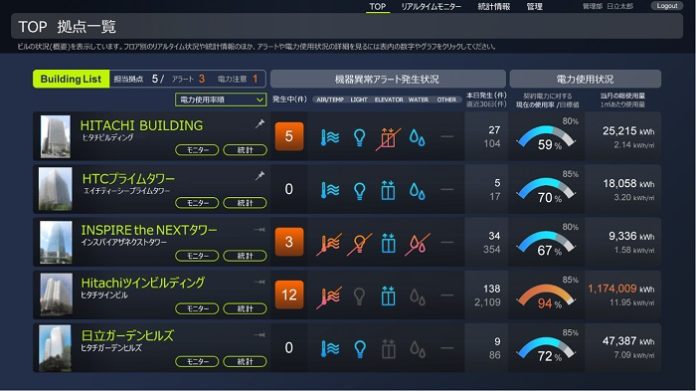Japanese company Hitachi announced that it has developed an IoT platform for the smart buildings space.
Hitachi will launch the IoT platform in the Japanese market this year, the company said.
Hitachi’s IoT platform for buildings was developed using Microsoft Azure and Microsoft Dynamics 365. ?Hitachi also said that it will deepen its collaboration with Microsoft Japan under its new partnership system, the Lumada Alliance Program, to develop solutions in the field of buildings and accelerate the overseas expansion of these solutions.
The IoT platform for buildings is a solution for developers that enables comprehensive remote monitoring and analysis of the operating status of building equipment, including elevators, escalators, and air-conditioning systems. Hitachi said that it is intended mainly for large buildings and also enables users to simultaneously monitor and analyze multiple buildings. In addition, it combines and analyzes data about building equipment and the flow of people, including the crowdedness of each area of a building.
“The newly developed IoT platform for buildings is a next-generation solution for buildings that realizes new and efficient operation managements for building equipment, and comfortable life in the buildings. I believe this platform contributes significantly to the customers that progress development of smart buildings and smart cities utilizing digital technologies,” said Shinya Mitsudomi, CEO of Hitachi’s Building Systems Business Unit and president of Hitachi Building Systems.
Hitoshi Yoshida, President of Microsoft Japan, said: “Microsoft Azure provides AI and IoT technologies that drive the digital transformation of customers, and it continues to grow as a global platform. Hitachi is actively developing smart building solutions for the new normal. We have high expectations that this platform will accelerate digital transformation in the building facility maintenance field. Moving forward, we will continue to grow our partnership with Hitachi, including expanding collaboration for overseas markets, and to work closely with our customers and drive digital transformation that leads to positive social change.”
According to Hitachi, the main features of the new IoT platform include:
-Improving building management efficiency. The platform makes it possible to comprehensively monitor the various equipment of multiple buildings remotely and visualize the status of use of the buildings.
-Improving building users’ comfort. Hitachi says the platform cooperates with control systems of building equipment, such as elevators, escalators and air-conditioning systems, based on data on the flow of people, including the crowdedness of each area of a building. By providing that information, it enables building managers to ease congestion, change temperature settings according to the crowdedness of each area, and otherwise create comfortable a building environment. It also provides information about the status of use and crowdedness of toilets, meeting spaces, and other areas.
-Maintaining and improving the quality of building operations. The platform maintains and improves the quality of the operations of multiple buildings by enabling users to benchmark the number of alerts activated, energy consumption, and other conditions within each building, to identify issues faced in operations, and consider improvement measures, according to Hitachi.
-Enabling to expand services by open APIs. By incorporating standardized open APsI, the platform enables to add new app by partner companies.

